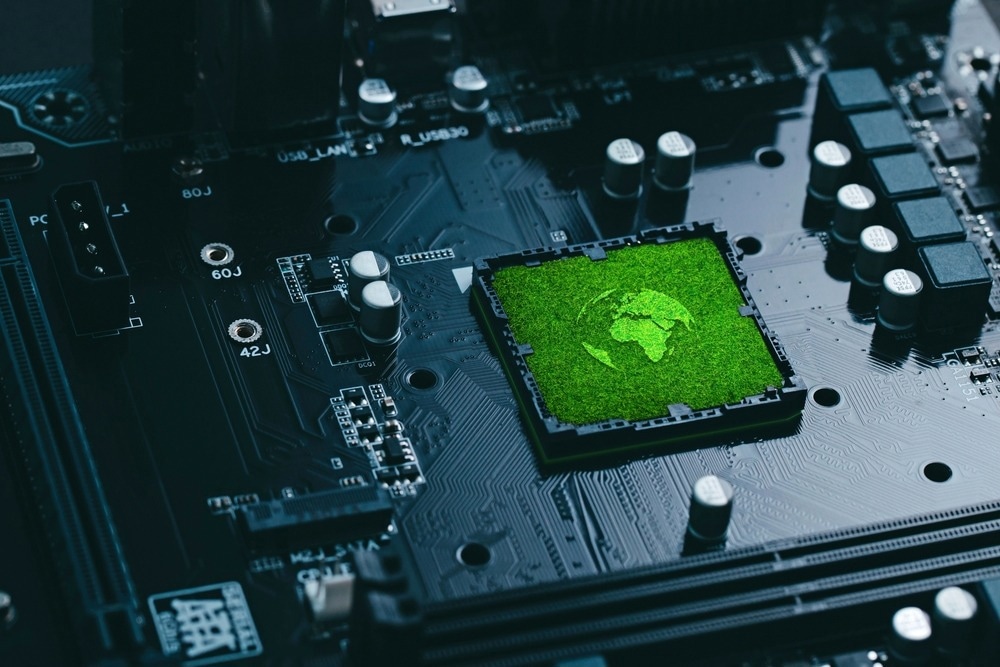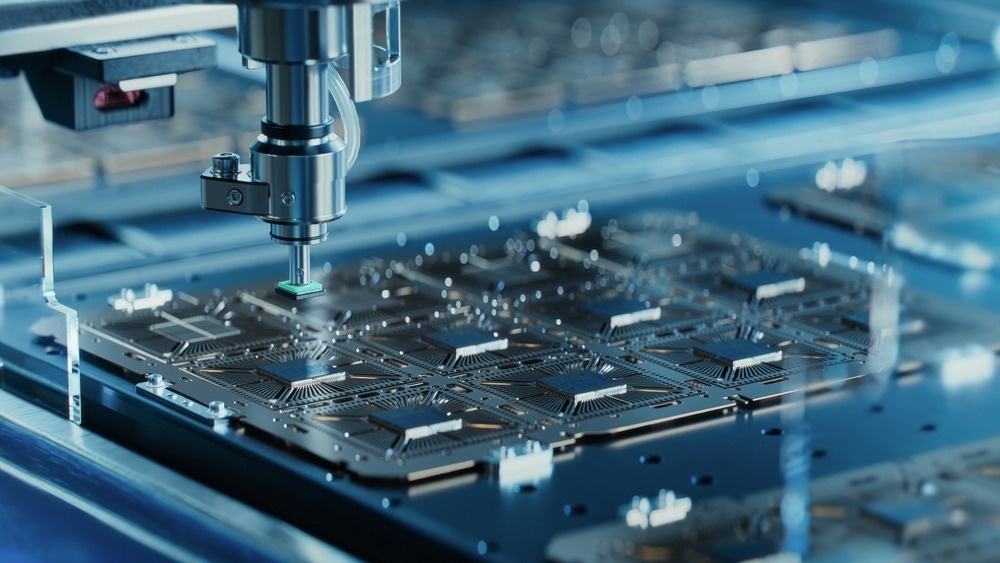Semiconductor chips are the building blocks of modern technology, powering everything from smartphones to electric vehicles. However, the manufacturing of these chips comes at a significant environmental cost. This has sparked debate around the sustainability of the semiconductor industry as it works to enable cleaner technologies while reducing its footprint.

Image Credit: chayanuphol/Shutterstock.com
The Role of Semiconductor Chips in Advancing a Green and Sustainable Future
The "electrification of everything" concept has gained prominence, signifying the drive to power traditionally fossil-fuel-dependent devices with clean energy sources. Semiconductor chips are at the forefront of this transformation, serving as the foundation for modern electrical grid systems, including wind, solar, and battery storage solutions. For example, wind turbines incorporate approximately eight thousand silicon-based components to efficiently convert DC power into grid-compatible AC electricity while minimizing energy losses.
Experts anticipate a substantial growth rate, between 8% and 10% annually until 2027, in the utilization of semiconductor chips in renewable energy markets as the global demand for supporting power electronics rises in parallel with the expansion of clean energy initiatives.
In addition to their influence on renewable energy technologies, semiconductor chips are indispensable in developing electric vehicles, making them a vital element in the shift toward greener transportation options. On average, electric cars are equipped with approximately 2,000 semiconductor chips, which function as the nervous system of these vehicles, enabling advanced control systems and significantly enhancing their safety, performance, and environmental sustainability.
The logistics and supply chain industries are embracing semiconductor-dependent solutions such as robotics and autonomous guided vehicles (AGVs) in warehouses to reduce their carbon footprint. With the incorporation of sensor networks within these facilities, there is an enhanced ability to monitor asset movement, all of which rely on semiconductor-based systems.
Furthermore, in the manufacturing sector, the silicon-dependent Industrial Internet of Things (IoT) drives transformation across entire industries, delivering superior productivity, cost-efficiency, and reduced time-to-value. Smarter electric tools boost productivity, optimize energy consumption, and enhance worker safety through improved sensing and tracking capabilities.
Overall, semiconductor chips play a fundamental role in advancing clean energy technologies, enabling efficient harnessing, conversion, transmission, and storage of renewable energy while driving electrification across industries and improving energy efficiency, making them indispensable for a cleaner and more sustainable future.
The Resource-Intensive Manufacturing Process
On the flip side, semiconductor chip production has a significant environmental impact. Semiconductor chip fabrication facilities (fabs) are highly complex and energy-intensive facilities where producing a single chip involves hundreds of steps, demanding significant energy, water, chemicals, and raw materials. These processes also involve greenhouse gases like perfluorocarbons and hazardous chemicals, which can pollute the environment if not properly managed.
A typical fab can use over 5 million gallons of water per day and consume 100 megawatt-hours of electricity per hour (upcoming 3nm chips would require 7.7 billion kilowatt-hours of power per year), driven by cleanroom operations, lithography machines, ion implanters, and climate control systems. For example, in 2020, TSMC emitted approximately 15 million tons of carbon and used 193,000 tons of water daily, equating to 70 billion liters annually, exacerbating environmental challenges during Taiwan's recent droughts.
Critics argue that the substantial resource requirements and emissions associated with chip fabrication are environmentally harmful and unsustainable, necessitating more than incremental improvements.

Image Credit: IM Imagery/Shutterstock.com
In response, chip manufacturers have made efforts to enhance sustainability. TSMC pledged to reduce water usage per chip wafer by 30%, adopted cleaner production systems, transitioned to renewable energy, and worked to phase out potent greenhouse gases used in manufacturing. Additionally, Dell has taken a sustainable approach by repurposing wastewater from chip manufacturing for landscape irrigation at its Xiamen, China facility.
Beyond manufacturing, sourcing raw materials for semiconductors raises sustainability concerns due to the scarcity of resources like high-purity silicon, gallium, tungsten, and tantalum. As global reserves deplete, obtaining these materials economically becomes challenging. However, continuous research efforts are exploring alternatives to these materials.
For instance, recently, MIT researchers demonstrated the potential of cubic boron arsenide as a semiconductor material. Its exceptional properties, including high electron and hole mobility and outstanding thermal conductivity, have led researchers to deem it the best semiconductor material ever discovered. This discovery marks a significant advancement in semiconductor materials, indicating the possibility of more sustainable alternatives.
Navigating the Semiconductor Paradox
Semiconductor chips present an environmental paradox; their manufacturing enables green economic progress yet causes environmental concerns. Navigating this paradox requires holistic solutions across policy, innovation, business strategy and multi-sector collaboration.
Chip manufacturers must continue improving efficiency, reducing waste, and investing in green technologies for chip production. Policymakers can support R&D and initiatives to develop greener semiconductors. At the same time, designers can create application-specific chips optimized for efficiency.
This journey towards sustainability in the semiconductor industry is complex, yet it may serve as a vital prerequisite for addressing broader global environmental goals. As chip ubiquity and demand soar, the environmental stakes rise, making it imperative to harmonize this crucial industry with sustainability principles through an integrated approach that merges ethics, economics, and environmentalism.
References and Further Reading
Harrington, Elise, Sairaj Dhople, Xiaojia Wang, Jungwon Choi, and Steven Koester. Sustainability for Semiconductors. Issues in Science and Technology 39, no. 1 (Fall 2022): 42–43. Available at: https://issues.org/sustainability-semiconductors-harrington-dhople-wang-choi-koester/
Jones Lang LaSalle IP Inc. (2023). How semiconductor firms are chipping in on sustainability. [Online]. Available at: https://www.us.jll.com/en/trends-and-insights/cities/how-semiconductor-firms-are-chipping-in-on-sustainability
Kalle Ylä-Jarkko. (2023). Sustainability In the Semiconductor Industry: The Power of AI and Machine Learning. [Online]. Available at: https://elisaindustriq.com/blog-semiconductor-sustainability-in-the-semiconductor-industry/
Lippett, M. (2023). Semiconductor Sustainability: COP27 And the Potential of Chips to Save Energy. [Online]. Available at: https://www.forbes.com/sites/forbestechcouncil/2023/02/03/semiconductor-sustainability-cop27-and-the-potential-of-chips-to-save-energy/?sh=2a8853c03aa7
Marwala, T. (2023). Semiconductor Chips for Sustainable Development. [Online]. Available at: https://collections.unu.edu/eserv/UNU:9267/UNU-TB_2-2023_Semiconductor-Chips-for-SD.pdf
Favino, C. (2022). The Role of Semiconductors in the Renewable Energy Transition. [Online]. Available at: https://earth.org/semiconductors/
Matta, M. (2023). The Future of Renewable Energy Is Built on Semiconductors. [Online]. Available at: https://www.forbes.com/sites/forbesbusinessdevelopmentcouncil/2023/09/08/the-future-of-renewable-energy-is-built-on-semiconductors/?sh=572413f116df
Pandey, M. (2023). Exploring the connection between semiconductor manufacturing and climate change [Online]. Available at: https://intlbm.com/2023/08/18/exploring-the-connection-between-semiconductor-manufacturing-and-climate-change/
Romero, C. (2023). Sustainability in Semiconductor Industry: Towards Greener Chip Production. [Online]. Available at: https://www.mrlcg.com/latest-media/sustainability-in-semiconductor-industry-towards-greener-chip-production-300690/
Shin, J., Gamage, G. A., Ding, Z., Chen, K., Tian, F., Qian, X., ... & Chen, G. (2022). High ambipolar mobility in cubic boron arsenide. Science, 377(6604), 437-440. https://doi.org/10.1126/science.abn4290
White, S. (2023). The Environmental Impact of Using Plastic to Make Microchips. [Online]. Available at: https://www.forbes.com/sites/forbestechcouncil/2023/04/19/the-environmental-impact-of-using-plastic-to-make-microchips/?sh=66e3c8ae1750
Disclaimer: The views expressed here are those of the author expressed in their private capacity and do not necessarily represent the views of AZoM.com Limited T/A AZoNetwork the owner and operator of this website. This disclaimer forms part of the Terms and conditions of use of this website.